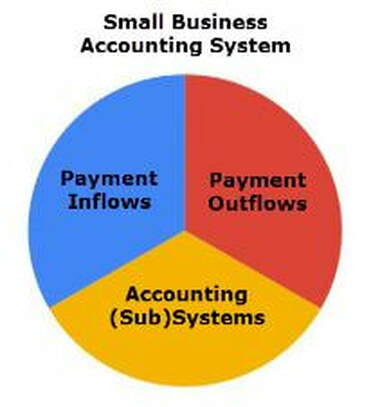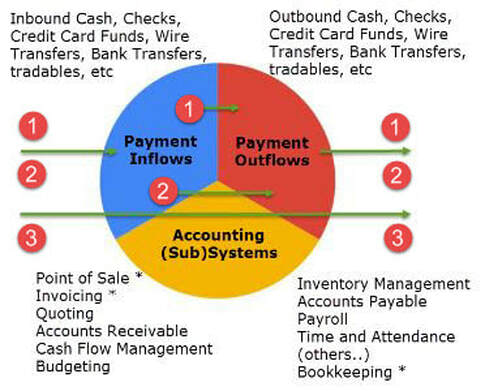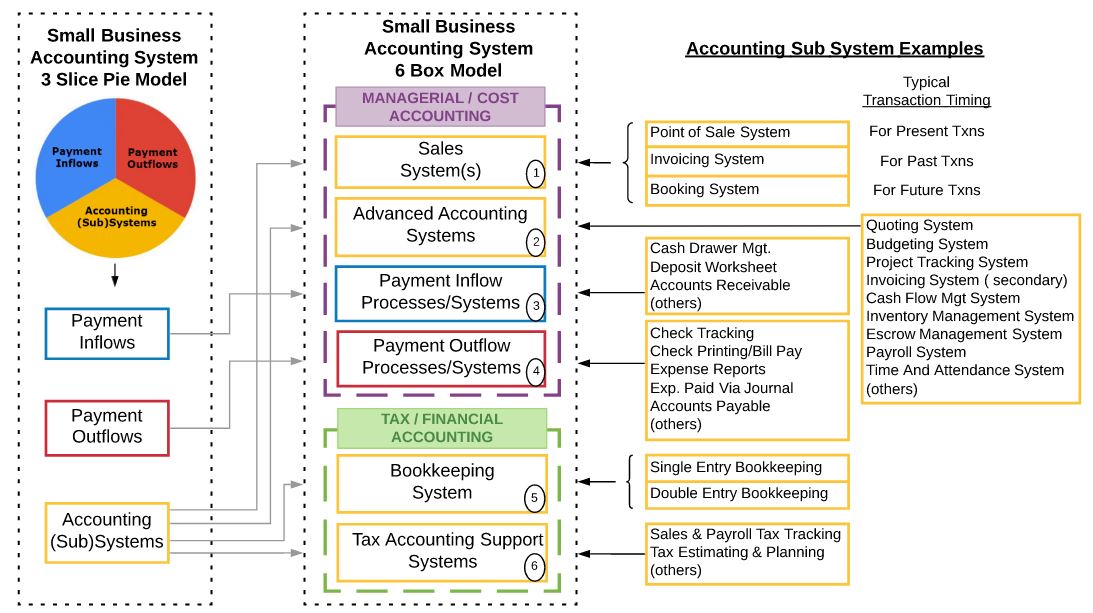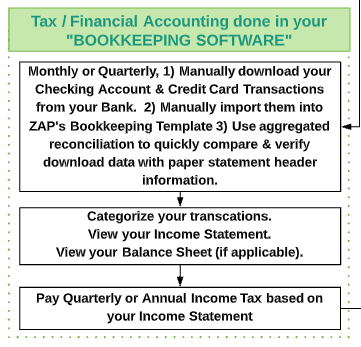Orienation > Models and Data flow for folks on the GO!
This is the accelerated way to learn about our systems and offerings. You are getting only the data models and flow charts with very little commentary. A lot can be conveyed given a picture is worth 1000 words.
The Sections Below include:
1) The Three Slice Pie Model - Model was the first model we used to develop our education and software. They convey ways to think about Accounting Systems generically and Hollistically.
2) The Six Box Model - This expands upon the Three Slice Pice Model. It helps delineate Managerial/Cost Accounting from Tax/Financial Accounting and it helps show people exactly where the "Bookkeeping" functionality is in a Holistic Accounting system. (near the bottom, because it's done in arrears)
3) The Simplicity List - A bulletted list which reminds you of the bigger picture. It identifies every small business person's basic needs in a generic way. If you read the top of this web page, you consumed it already. KISS. "Keep it Simple and Silly"
4) The "Intro to Bookkeping and Accounting via Invoices and Monthly Statements Flowchart" was created to help bring the Simplicity List and the 6 Box Model to life. Follow both paths twice, learning more with every pass. The distinction and clear separation between Managerial/Cost Accounting and Tax/Financial Accounting is the key takeaway. It takes 6 minutes to digest.
5) The BK Data Flow subdomain - a one page website that details the data flow for our Bookkeeping Template. Once you understand the health that separation between Managerial/Cost Accounting and Tax/Financial Accounting provides, this will become a valuable resource for understanding the data flow on the Tax/Financial Acocunting Side of the models.
Comments
1) The Three Slice Pie Model - Model was the first model we used to develop our education and software. They convey ways to think about Accounting Systems generically and Hollistically.
2) The Six Box Model - This expands upon the Three Slice Pice Model. It helps delineate Managerial/Cost Accounting from Tax/Financial Accounting and it helps show people exactly where the "Bookkeeping" functionality is in a Holistic Accounting system. (near the bottom, because it's done in arrears)
3) The Simplicity List - A bulletted list which reminds you of the bigger picture. It identifies every small business person's basic needs in a generic way. If you read the top of this web page, you consumed it already. KISS. "Keep it Simple and Silly"
4) The "Intro to Bookkeping and Accounting via Invoices and Monthly Statements Flowchart" was created to help bring the Simplicity List and the 6 Box Model to life. Follow both paths twice, learning more with every pass. The distinction and clear separation between Managerial/Cost Accounting and Tax/Financial Accounting is the key takeaway. It takes 6 minutes to digest.
5) The BK Data Flow subdomain - a one page website that details the data flow for our Bookkeeping Template. Once you understand the health that separation between Managerial/Cost Accounting and Tax/Financial Accounting provides, this will become a valuable resource for understanding the data flow on the Tax/Financial Acocunting Side of the models.
Comments
- The dividing line we draw initially between Managerial/Cost Accounting and Tax/Financial Accounting is based on an arbitrary rule in the US tax code related to a $5 Million/year revenue threshold. Above $5 Million in sales and you will find a minor shift in the dividing line we share initially. Learn it the way we've presented it. Once you have it down, we'll tell you the fibs we created to get you to the next level.
- If you are only here for a Bookkeeping Solution and not a Sales System or other Mangerial/Cost Accounting Supplements, the "Intro to Accounting via Invoices and Monthly statements flowchart" is still your best first step for education. Even if you have a Sales System you want or need to stick with, consume our education as presented first just to make sure your foundations are well laid and then move on.
- Our Bookkeeping Solution requires zero knowledge of debits and credits for initial use making it unlike any other commercial, double entry software solution in the marketplace. An opportunity to learn about them abounds for those who wish to do so, but as you will see, they are not required for any data entry. For fun, there is a switch you can use to turn Debits and Credits on and off on the backend for experiential education.
- All FIVE of these tools can be found on the first page on the Orientation Menu. If nothing else, check that out before reaching for the free software templates.



